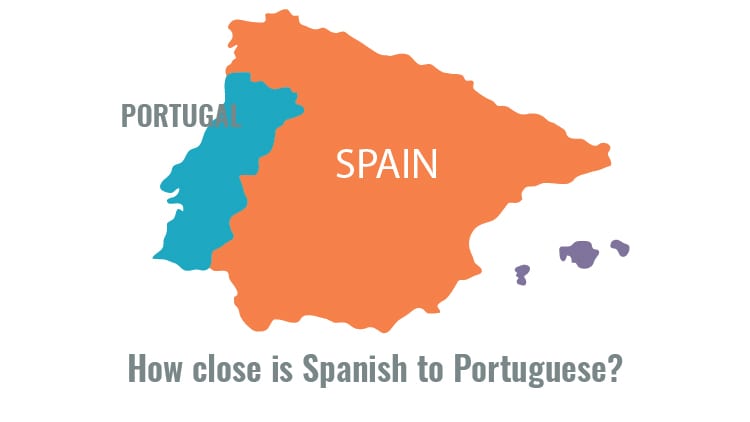How Close Is Spanish To Portuguese?

The Origin of the Romance Languages:
Most of the popular European languages of today originated from Latin. It was during the Roman Empire that the Latin language became popular in the Iberian Peninsula. The Latin of that time was divided into two varieties: Classical Latin and Vulgar Latin. The latter was the one used by the common people. After the fall of the Roman Empire, Vulgar Latin came into contact with regional vernaculars and gave birth to French, Spanish, Italian, Portuguese, Romanian, and Sardinian.
Even the less popular languages spoken in Europe today have Latin roots. All of these European languages spread to different parts of the world due to colonization, which is why they have different varieties today. For instance, there is European Portuguese, which is spoken in Portugal and Brazilian Portuguese. The Spanish language, which is spoken in Spain, is not the same as Latin American Spanish.
Vulgar Latin was so powerful that even languages like English that aren’t directly related to it have been influenced by it. This proves that even a dead language can continue to live in some form.
The Portuguese Language:
Portuguese is a Romance language that evolved from a dialect of Vulgar Latin in the Iberian Peninsula. Most people know of it as the official language of Portugal, but it is also the sole officially recognized language in Brazil. In the latter country, it is known as the Brazilian Portuguese. The Portuguese language is also spoken in Africa and Asia. It is one of the world’s most spoken vernaculars. Although Latin America is the home of the Spanish language and culture, Portuguese is the second most spoken language in the region. A speaker of this vernacular is called Lusophone.
The Spanish Language:
This is another European language that originated in the Iberian Peninsula from Vulgar Latin. Spanish is the official language of more than twenty countries today. It was the Spaniards’ colonization of the Americas that resulted in the widespread use of this language. It is spoken in Latin and South America as well as Europe. Today, it is the world’s second-most-spoken native language after Mandarin. It belongs to the Ibero Romance language family.
It is the second most spoken language in the United States. English is a foreign language for US citizens who are native speakers of Spanish. These are often Mexican or Cuban immigrants.
The Connection Between the Romance Languages:
Although all the Romance languages originated from Vulgar Latin, they are not mutually intelligible. Vulgar Latin had various dialects. The various European vernaculars originated from different dialects, which is why they are not mutually intelligible. However, despite not being mutually intelligible, these vernaculars share a few similarities with each other. They also share a few features with English due to the popularity of the latter.
In order to learn about the lexical similarity between Italian, French, Portuguese, Spanish, and Romanian, it is important to remember that they have different varieties. Even if there is one language spoken in a country, it will have different dialects. But Spanish, Portuguese, and French are also spoken in different countries, which is why they have become different in a lot of ways. A native speaker of Rio De Janeiro will be able to communicate with someone from Portugal, but they might not be able to understand slang words.

How Close is Spanish to Portuguese?
Spanish and Portuguese are the most popular daughter languages of Vulgar Latin. European colonialism took them to different parts of the world. If you compare Brazilian Portuguese to European Portuguese, you will find plenty of differences. But what about the languages of Portugal and Spain? How close are they to each other?
Interestingly, they share a lot of similarities in their written form. The written varieties are mutually intelligible to a certain extent. But it is in the meanings of words and the pronunciation that the differences lie.
Several cognates in the two vernaculars differ in meaning, which is why they are called false friends.
The usage of verbs is also different in the two languages. A common example is the frequent usage of reflexive verbs in Spanish. Also, in Spanish, a perfect tense is constructed with an auxiliary verb.
Vowel reduction is apparent in Brazilian Portuguese. It is a feature that not only separates it from European Portuguese but also from Spanish.
Portuguese originated from Medieval Galician, which is why it belongs to the Galician-Portuguese group. Spanish, on the other hand, belongs to the Castilian languages group of the West Iberian branch. However, it is important to remember that both vernaculars belong to the Indo European family.
Muslims ruled Spain for a long time, which is why the influence of Arabic on European Spanish is clear. However, the Portuguese lack this influence, which has made it closer to other European vernaculars like German, French, Italian, and English.
Both of these vernaculars have taken plenty of loanwords from English, which is why they have a few common words.

Is Spanish and Portuguese the same Language?
Whether it is due to their English loanwords or false friends, many people think that Portuguese and Spanish are the same. In truth, they are very different. Even their varieties, like Chilean Spanish and European Portuguese, have many differences. Portuguese, which originated from Medieval Galician, shares a few similarities with Catalan, which is the second most popular language of Spain. But none of these European vernaculars are mutually intelligible, which proves that they are different languages.
So, if you hire a Spanish-to-Portuguese translator, make sure they are a native speaker of the latter so they can provide you with accurate translations.
Do Spanish people understand Portuguese?
The English of America and Britain are not the same, but their speakers can still understand each other because the varieties are mutually intelligible. However, when it comes to Spanish and Portuguese, the situation is different because they are not the same language. They do have some lexical similarity but they are different in many ways. Someone from Uruguay or Argentina cannot communicate with a Brazilian. However, similarities do help with language learning. So, a speaker of Castilian Spanish can learn Portuguese quicker than someone who doesn’t know a Romance language.




